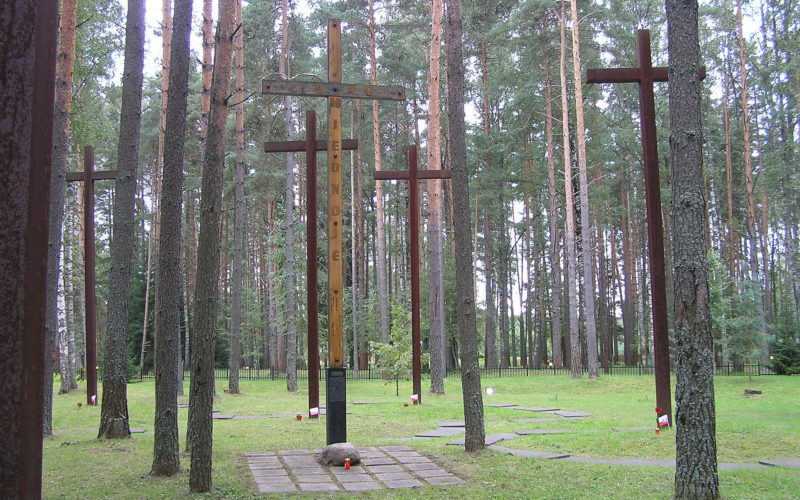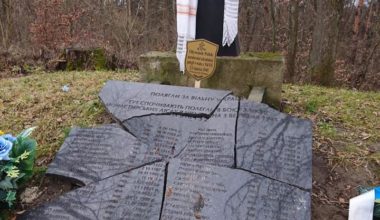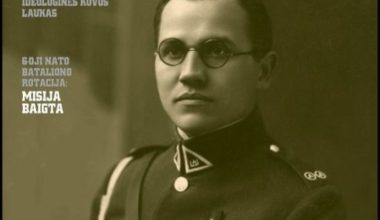On March 5, 2020, 80 years after the Politburo of the Central Committee of the All-Union Communist Party (Bolsheviks) decided to shoot Polish prisoners of war, RIA Novosti news agency published a material titled “Popularization of Katyn endorsed by Hitler: who was the real killer of the Poles?” The article was based on the inteview of Vladislav Shved, the ex-Second Secretary of the Communist Party of Lithuania. It contained “arguments” supposed to prove that the murder of Polish PoWs was committed by Nazis and not by the Stalin’s NKVD. In our publication, we will try to deny all such “arguments” as inconsistent.
First, we need to decide upon the terminology we are going to use. The “crime of Katyn” itself is a collective term for the executions, from April till May of 1940, of almost 22,000 Polish citizens from different NKVD camps and prisons, including:
– over 14,000 Polish military and police officers imprisoned by the Red Army in September 1939 and kept in three NKVD camps for PoWs. Those were Kozelsk (mostly shot an buried in Katyn forest near Smolensk), Ostashkov (mostly shot in Kalinin and buried in Mednoye), and Starobelsk PoW camps (shot an buried in Kharkov);
– over 7,000 of arrested persons kept in prisons in the western regions of the Ukrainian and Belarussian Soviet republics (apparently shot in Kiev, Kharkov, Kherson and Minsk).
Katyn, one execution site in a row, became a symbol of mass killings of all the aforementioned groups of Polish citizens since it was near Katyn that graves of killed Polish officers were first discovered in 1943. Forty-seven years after that discovery, Katyn remained the only established burial site of those killed in that NKVD “operation”.
History as a science deals with no “alternative versions” of the Katyn massacre. It deals with the proved fact of mass shooting committed near Smolensk, in Kharkov and in Kalinin in the spring of 1940 by the NKVD under the orders of the Politburo of the central party committee. The substantial proof stems particularly from
- the fact that 14,000 PoWs from Kozelsk, Ostashkov and Starobelsk camps totally disappeared in the spring of 1940 (one can not find those PoWs either in combined or individual stats of the Main Directorate for POWs and Internees, or in combined or individual stats of the GULAG);
- official Soviet documents, mid– and top-level;
- evidence given by former Cheka members involved in preparing the executions;
- official Soviet-Polish and Polish exhumations results received in the 1990s (See e.g. protocols of exhumation protocols in vol.3 of Killed in Kalinin, buried in Mednoye («Ubity v Kalinine, zakhoroneny v Mednom»).
It is also worth noting that the Chief Military Prosecutor’s Office of Russia officially acknowledged the murder of Polish prisoners of war in Katyn forest by the NKVD. In its formal letter, the Office reported, “Early in May 1940, the materials on the murder cases were submitted to a special troika, an extrajudicial body, that studied the cases of 14542 Polish citizens (10710 in the Russian Soviet Federative Socialist Republic and 3832 in the Ukrainian Soviet Socialist Republic), found them guilty of crimes against state and sentenced them to be shot. The investigation reliably confirmed the deaths of 1803 Polish PoWs as a result of that troika judgment, 22 of them identified.”
The total number of victims, 1803, is a sum of 1380 bodies exhumed by Dr. Burdenko’s commission in Kozyi Gory in 1944, 13 bodies at the same place in 1991, 243 bodies in Mednoye near Kalinin (Tver) and 167 bodies in Pyatikhatki near Kharkov in 1991. This means that the military prosecutor’s office recognized only Soviet and Soviet-Polish exhumations, ignoring the Polish (partial) exhumations that discovered several thousand remains in Mednoye (2115 victims) and Pyatikhatki (2145 victims). Nevertheless, the truth is that the Chief Military Prosecutor’s Office recognized all bodies unearthed by the Soviet commission in 1944 as NKVD victims.
Vladislav Shved, unable to explain the evidence of the NKVD guilt, uses the well-known trick of all history deniers. He weaves a web of minor and non-essential facts to get the reader captured, distorting the truth all on the way.
For example, he points out the discrepancy between the number of identified victims in German and Polish sources, coming to the conclusion that “Poles had to cross the names of 179 Polish officers, exhumed and identified in Kozyi Gory, from their lists since they turned out to be alive.” However, after the verification of the names from the German list, it turned out that only 41 names from it have no cross-reference with the NKVD instructions regarding the transfer of Polish PoWs from Kozelsk camp under the supervision of the Smolensk NKVD directorate (“Ubity v Katyni”, 2015, p. 74-77).
Shved says that the evidence of Katyn shootings were their correspondence, IDs, military decorations, and other personal belongings. However, PoWs in camps were allowed to have “letters, photographs of the family, medical certificates, etc.”
The few surviving PoWs recalled that, before they were transferred, the camp administration had spread the message that they were sending them home, to Poland. This did have an effect. The report of the NKVD Boarder Guard – on the sentiments among the PoWs transferred from Starobelsk, Kozelsk and Ostashkov camps – tells us that “the overwhelming majority of imprisoned officers are sure that they are going home.” Before they were delivered to the execution site, nothing was to raise doubts in them. It would be strange if they didn’t get their IDs back. This would ruin all the secrecy.
Owen O’Mally, British ambassador to the Polish government-in-exile, was fully aware of the situation. Based on the information from Polish former camp prisoners (transferred to Gryazovets), he wrote, in his detailed report to Foreign Secretary Eden of 31.05.1943 that, in some cases, Polish documents were taken away, but in many other cases they were returned before the transfer.
It is true that wearing military insignia were forbidden in camps. But here we deal with the situation in which people were leaving the camp, not dwelling in it. Again, survivors remember that, when Gen. Minkiewicz, Smorawinski and Bohaterewicz were about to leave the camp, the administration arranged for them a huge celebration with pancakes. The generals left the camp triumphantly passing cheering rows of officers. Most probably, they were in full dress and decoration, which was later found in their graves. The same is true for other officers.
The high probability of that scenario is also confirmed by the fact that, according to the “Special report on negative aspects of political consciousness and morale, as well as emergency situations in PoW camps from Dec 1 till 31, 1939”, officers kept in the Kozelsk camp violated all the rules trying to wear military decorations and shoulder marks. The documents said Polish PoWs “while in the camp, want to retain shoulder boards, orders and respect for rank.”
A memo “On the situation in the Kozelsk NKVD PoW camp as of Dec 1, 1939” reports that “a number of officers, when kept together with soldiers, cut off their stars; but now that only officers are prisoners of the camp, they started to restore hierarchy, some of them bringing their stars back on their shoulder boards.”
Also untenable is Shved’s assertion that “from Grave No.1, layered with dead bodies nine-fold to twelve-fold, the Nazi exhumers first extracted the remnants of Polish generals Mieczysław Smorawinski and Bronisław Bohaterewicz.” In fact, we do not know from which grave they were extracted from. Yes, one of the early propaganda messages mentioned one large grave and the fact that the generals had been found, but this does not imply that was the only grave from which the bodies were extracted.
Before systematic excavation work was underway, Germans had found 112 bodies. Only after that did they introduce a new numbering system, starting from 01 to 04143. In a symbolic act, Gens. Smorawinski and Bohaterewicz, numbered No.96 and No.97, were put in the beginning of the “main” list later published in Amtliches Material, renumbered as No. 01 и No. 02. Thus, those numbers do not mean they were found first. Neither there is reason to believe that they were found in the largest grave. Consequently, Shved’s conclusion that “the real location of the Polish generals’ remnants could only be known to those who shot them” seems pointless.
Another argument, containing the same degree of absurdity, is that there were “steel” bullet cases found in Katyn graves, made after 1940. Shved is sure that they were made of steel rather than brass only because they were not corroded. However, brass is often subject to corrosion, too. N. Poddubny, author of the book on the corrosion of arms and ammunition (Korroziya oruzhiya i boepripasov, 1946, p. 35), writes that «Where brass objects are stored, one has to control the air to avoid large quantities of ammonia. The most common sources of ammonia are toilets, stables, cesspools and other places where rotting and organic decay take place…” Moreover, a smell of chlorine was in the air during exhumations in Katyn (Amtliches Material, p. 53), meaning that calcium hypochloride had probably been used to eliminate the rotten smell and to disinfect the graves. Chlorine compounds are known for their highly negative effect on brass.
Shved says that bodies in the graves were layered in an orderly manner (although the German reports writes that only part of the burial site seemed to be well-ordered), which, for him, means that NKVD officers would not waste their time carefully arranging the bodies of those executed (which is not true for the Great Terror years when Cheka officers were often involved in moving bodies); and that one source speaks of wartime Polish banknotes in the graves, insisting such banknotes appeared much later (in reality, 2-zloty notes were in circulation starting from the first weeks of the war).
The assertion that Germans possessed Soviet lists of the executed Polish officers is based on a mistake: The State Archive of the Russian Federation contains (stock: 7021, inventory: 114, file: 33) the German translation of the list of Poles from Kozelsk-2, who were interned in Lithuania and Latvia before summer of 1940 and bore no relation to those shot in Katyn.
Shved also shows some misperception in his statement that the Polish addresses from the German list looked anachronistic. The matter is that names of places were often Germanized intentionally rather than transliterated, which can be seen from the exhumed papers that partly survived to this day.
Finally, contrary to Shved’s opinion, the Soviet attempt to make everybody in Nuremberg think that Germans were to blame for the crime of Katyn was a complete failure. One of the high-profile issues of the case, it was not mentioned in the final judgment. Friedrich Ahrens whom Dr. Burdenko’s commission report accused of the Katyn executions, testified during the interrogation that he arrived in Katyn long after the dates mentioned by Soviet “witnesses” (later, this was proved documentarily).
Those who try to blame Germans for Katyn have different motives. Some do it in an attempt to whitewash Stalin and Stalinism, others out of falsely viewed patriotism. However, attempts to prove the untenable “German trail” theory inevitably run aground. The article by RIA Novosti does not even make a slightest attempt to explain the substantial body of evidence of Soviet guilt that exists today. Neither does it try to explain the key issue of the Katyn case: where were over 14,000 Polish PoWs from the spring of 1940 till the summer of 1941?


